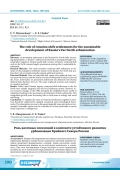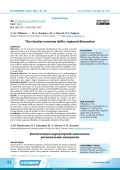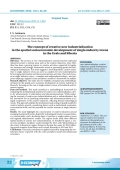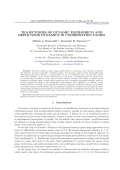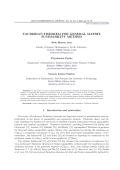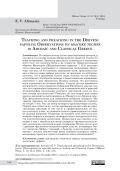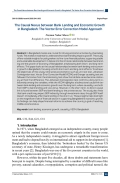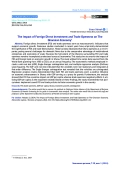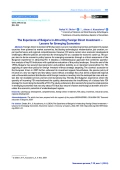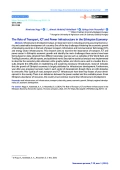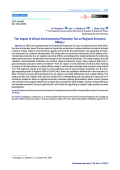Relevance. As permanent settlements in the Russian Far North suffer increasing depopulation, a “shadow” settlement framework is emerging through rotational labor migration. Despite nearly half a century of history, rotational shift work in the North remains largely spontaneous, posing risks to sustainable development. Research Objective. This study examines rotational shift settlements as elements of the population settlement system in the Russian Far North and analyzes their role in transforming the region’s settlement patterns. Data and Methods. Data on rotational shift camps were gathered from various open web sources and the Ministry for the Development of the Far East and the Arctic. Information on permanent settlements was obtained from Rosstat (Federal State Statistics Service). The study employed systemic and comparative analysis methods. Results. Unlike other Russian regions, rotational shift settlements in the Far North were initially integrated into the local settlement system. However, socio-economic changes in the 1990s disrupted the established Soviet model of integration, leading to the spontaneous development of these settlements. This unregulated growth poses increasing risks in such areas as ecology and social well-being. Conclusions. To regulate the status of rotational settlements, legislative initiatives should be supported by updated conceptual and terminological frameworks. The urbanization process in this geostrategically important and environmentally vulnerable region must be controlled or at least predictable to ensure timely responses to emergencies.
Relevance. In the pursuit of sustainable development, the circular economy takes precedence as a fundamental imperative for industrial transformation. The current trend in the development of the circular economy concept is to place the main focus on the technological support of circularization and the corresponding innovations in business models, while the decisive role people play in this model of economy is often overlooked. Individuals with specialized knowledge, skills, and values are essential for developing and implementing circular models, making effective management decisions, and promoting rational consumption patterns. The demand for circular skills and the availability of relevant competencies can significantly differ across regions, necessitating further in-depth study. Research objective. The paper is aimed at developing a new methodological approach to the study of circular economy skills at the regional level. This approach considers these skills in terms of both employer demand and their incorporation into master’s degree programs, accounting for regional specifics. Data and methods. The study employed a comprehensive approach, integrating theoretical methods with empirical analysis. Scientometric and content analysis identified taxonomies of circular economy skills, and employers’ personnel needs were examined through the analysis of the HeadHunter job site using Python software. Additionally, the study encompassed an analysis of educational programs from official websites of universities in southern Russian regions. Results. A new approach to the study of supply and demand of circular economy skills at the regional level has been proposed and tested. As a result, it was determined that there is a demand for sustainable development specialists in various industries in the Russian labor market, which varies across different regions of the country. The relevant skills are included in the master’s degree programs offered by universities. There is a need for greater involvement of regional authorities in shaping educational demands presented to universities, as this is essential for generating demand in the job market for the corresponding competencies. Conclusions. To better achieve targets in sustainable development and facilitate the transition to a circular economy, it is essential to promote a balanced development of all the relevant skills and behavioral patterns. To ensure this, it is important to involve regional authorities in shaping the demand for these skills.
Relevance. The process of new industrialization extends beyond traditional industrial sectors to include areas such as the creative industries. Since 2021, there has been a growing interest in creative activities, supported by legislative measures and strategic frameworks aimed at promoting spatial and technological development. This trend suggests a novel hypothesis: creative industries in single-industry towns can serve as catalysts for new industrialization by leveraging information and telecommunications activities. This study focuses on single-industry towns-a complex and underexplored subject-and proposes adopting a regional ‘center-periphery’ model as a framework for analysis. Research objective. The study aims to establish conceptual and methodological bases for the spatial socio-economic development of creative industries in Russia by focusing on the case of single-industry towns of Sverdlovsk and Kemerovo regions. Data and methods. This study introduces a methodological framework for evaluating the developmental potential of creative new industrialization, driven by advancements in information and telecommunications. While exploring the concepts of creative neo-industrialization and re-industrialization, the key innovation lies in classifying information and telecommunications as integral components of the creative industries, reflecting broader technological trends. This approach enables the development and testing of spatial models for creative industry growth, considering factors such as institutional constraints, concentration levels, and the potential for creative startups in single-industry towns. Results. The study highlights the concentration of creative industries around emerging local growth points, shaped by technological trends, increased industry concentration, and a declining share of startups in single-industry towns and regional administrative centers. The regions under study show different spatial models of creative new industrialization. In Sverdlovsk region, a center-semi-periphery-periphery model emerged by 2015, with Yekaterinburg at the center. In Kemerovo region, Kemerovo became the center by 2022, following growth transfers from Belovo and Leninsk-Kuznetsk in 2019 and 2021. Conclusions. This study contributes to applied research by integrating the evolutionary theory of growth with the center-periphery model and institutional economics.
The paper analyzes average integral payoff indices for trajectories of the dynamic equilibrium and replicator dynamics in bimatrix coordination games. In such games, players receive large payoffs when choosing the same type of behavior. A special feature of a 2 × 2 coordination game is the presence of three static Nash equilibria. In the dynamic formulation, the trajectories of coordination games are estimated by the average integral payoffs for a wide range of models arising in economics and biology. In optimal control problems and dynamic games, average integral payoffs are used to synthesize guaranteed strategies, which are involved, among other things, in the constructions of the dynamic Nash equilibrium. In addition, average integral payoffs are a natural tool for assessing the quality of trajectories of replicator dynamics. In the paper, we compare values of average integral indices for trajectories of replicator dynamics and trajectories generated by guaranteed strategies in constructing the dynamic Nash equilibrium. An analysis is provided for trajectories of mixed dynamics when the first player plays a guaranteed strategy, and the behavior of replicator dynamics guides the second player.
In this paper, we prove certain Littlewood-Tauberian theorems for general matrix summability method by imposing the Tauberian conditions such as slow oscillation of usual as well as matrix generated sequence, and the De la Vallée Poussin means of real sequences. Moreover, we demonstrate (N, pn) and (C, 1) - summability methods as the generalizations of our proposed general matrix method and establish an equivalence relation connecting them. Finally, we draw several remarks in view of the generalizations of some existing well-known results based on our results.
По свидетельству целого ряда античных авторов, в том числе и в составе недавно обнаруженного трактата Галена «О моих воззрениях», Протагор предлагал усомниться в отношении всего того, что касается богов и их сущности. Примечательным образом Филострат (Жизнеописания софистов 1.10.2) источник этого сомнения усматривает в «персидском воспитании» Протагора, так как, по его мнению, персидские маги, продолжая взывать к богам в своих тайных ритуалах, не признают это публично, опасаясь, что в противном случае люди, осознав, что их сверхъестественные способности связаны с божественными влияниями, перестанут к ним обращаться. Иными словами, так рассуждая, маги стремились не потерять работу. Следует ли нам принимать историчность этого странного сообщения Филострата или же считать его отражением типичного для эллинистической и римской историографии стремления усмотреть «восточный след» во всяком учении или искусстве? Ответить на этот вопрос нам может помочь знаменитое высказывание из Папируса из Дервени (кол. XX), фундаментальное для понимания авторства папируса. Мы увидим причины, по которым невозможно однозначно ответить на вопрос о том, был ли автор папируса практикующим τελεστής. Однако нам станет ясно, что он противопоставляет себя не практикующим мистерии (в том числе и профессионально), но тем, кто участвует в них, не понимая смысла происходящего и «даже не задавая вопросов». Напротив, он намерен дать ответы на возможные вопросы и раскрыть истинный смысл авторитетного текста экзегетическими средствами. Попытаемся мы ответить и на вопрос о том, с какой целью автор папируса стремился использовать различные космологические ассоциации. Имеем ли мы дело с древним «филологом-комментатором», или же, ассоциируя Зевса с воздухом, Мойру с пневмой, а Деметру и другие женские божества с землей, неизвестный автор стремится раскрыть тайну, намеренно скрытую в поэме и понятную лишь посвященным?
It is generally accepted by many scholars that British and American English vary greatly. This is not just a simple assumption about the phenomenon, but rather a well-grounded opinion. On the basis of extensive analysis conducted on differences between the two variations of English, linguists assume that the two vary mainly in grammar patterns and vocabulary choice. This article addresses the question of differences in vocabulary choice focusing on political vocabulary. It compares the most commonly used political words in British and American news reports and reveals distinct contrasts concerning word choice. A comparative analysis with the help of the corpus-driven approach has been chosen as the best procedure to investigate the material under study and demonstrate the mentioned differences.
In Bangladesh, banks are crucial for driving economic activities by channeling funds. This makes it essential to understand how bank lending impacts growth. This study offers valuable insights for policymakers to fine-tune financial policies, supporting stable and sustainable development. It delves into the intricate relationship between bank lending and the growth of economy of Bangladesh, emphasizing both short- and long-term effects. This paper looks at the causal relationships between bank lending and economic growth in Bangladesh, focusing on both short-term and long-term effects. To achieve the objectives of this study, time series econometric such as unit root test, Johansen Cointegration test, Vector Error Correction Model (VECM), and Granger causality test are followed. Outcomes from the stationarity test show that all data series become stationary at their first difference. The Johansen Cointegration test confirms a long-term relationship among the variables, while the VECM highlights a bidirectional causal link between bank lending and economic growth over the long term, where causality runs both from GDP to bank lending and vice versa. However, in the short term, no direct causal link is found between GDP and bank lending to the private sector. The study also finds that bank credit may impact GDP indirectly through investment rates, though GDP itself doesn’t immediately affect bank lending in the short run. These insights help shed light on the magnificent role of financial sector in supporting Bangladesh’s economic growth. Its findings can help shape financial reforms to achieve the country’s goal of reaching middle-income status.
Foreign direct investment (FDI) and trade openness serve as macroeconomic indicators that support economic growth. Numerous studies conducted in recent years have empirically demonstrated the significance of FDI and trade liberalisation. Historical data illustrates that Ghana operates as a net importer, posing several challenges for domestic firms due to the comparative advantage of multinational enterprises and economies of scale. However, the full extent of the theories surrounding FDI and trade openness remains incompletely understood across all economies. This study aims to uncover the impact of FDI and foreign trade on economic growth in Ghana. The study utilised time series data sourced from the World Bank spanning from 1985 to 2021, on an annual frequency. The econometric methods employed include a unit root test (ADF), Engle-Granger cointegration test, and multiple regression analysis (Ordinary Least Squares). The ADF unit root test indicated that the variables were non-stationary and integrated at first-order difference. The Engle-Granger cointegration test revealed that the variables are cointegrated. Regression analysis results demonstrated that both FDI and trade openness exert a positive influence on economic enhancement in Ghana, with GDP serving as a proxy for growth. Furthermore, the analysis showed that FDI has a positive impact on GDP per capita, whereas trade openness negatively affects it, utilising GDP per capita as the explained variable. Based on these findings, the study recommends that policymakers implement sound FDI and trade policies to foster economic growth in the country.
Foreign direct investment (FDI) has been crucial in transitioning Central and Eastern European countries from planned to market economies, facilitating technological modernisation, job creation, export performance, and regional competitiveness. However, FDI alone cannot solve economic development challenges; effective policies are essential for leveraging FDI as a catalyst for economic catch-up. This paper aims to derive economic policy lessons for emerging economies through a critical assessment of the Bulgarian experience in attracting FDI. It employs a methodological approach that combines quantitative analysis of key FDI indicators with qualitative evaluation of the policy landscape. Since the end of the 1990s, Bulgaria has secured macroeconomic and political stability as an important precondition for FDI, applying an open-door policy for foreign investors without strategic targeting. The country’s accession to the European Union in 2007 further enhanced its investment appeal. Nevertheless, the passive policy of reliance on a low tax regime and low labour costs without a strategic focus has led to unbalanced regional and unfavourable sectoral distribution with foreign investors crowding into the metropolitan area and sectors like non-tradable services and low-end manufacturing. Thereby, the Bulgarian experience, where the quantity of incoming FDI overshadowed the quality, demonstrates the insufficiency of a laissez-faire FDI strategy for maximising the benefits of FDI. The study underscores the necessity for proactive state policies in emerging economies that not only attract FDI but also ensure it fosters technological transfer and stimulates the economic potential of underdeveloped regions.
Infrastructure development plays an important role in reducing poverty, assuring food security and sustainable development of a country. One of the key challenges hindering the economic growth of developing countries is the lack of proper transport, Information and Communication Technology (ICT), and energy sector infrastructures. This research aims to examine the importance of transport, ICT and power sector in Ethiopia’s economic growth and identify the main challenges these sectors have been facing based on data obtained from different secondary sources such as websites of the World Bank and Trading Economics, official reports, and published works. Descriptive statistical analysis was implemented to describe the secondary data obtained, while graphs, tables, and charts were used to visualise the results. Despite the difficulties in establishing and sustaining necessary infrastructure, research indicates that the growth of Ethiopia’s economy is largely attributed to infrastructure development. Furthermore, year after year, progress has been made in each sector of development, though there are still obstacles to overcome. Poor quality of road, transport and ICT infrastructure have been key factors of poor development in the country. There is an imbalance between the power needed and the available power. Given Ethiopia’s abundance of resources, the country must continue to prioritise infrastructure development.
In 2018, China adopted the Environmental Protection Tax Law, transitioning from administrative fees to statutory taxes. The law aimed to incentivize enterprises to reduce pollution emissions through economic means, improve environmental quality, and promote the optimization and upgrading of industrial structures for economic development. This study seeks to reveal the mechanisms of the impact of environmental protection tax on regional economic effects, providing policy recommendations for achieving high-quality economic development and ecological environmental protection. The study analyses four key variables-environmental protection tax revenue, regional industrial output value, regional GDP, and regional industrial pollution control investment-from 31 regions in China between 2018 and 2022, forming a sample of 30 observations. A random effects model is constructed and empirically analysed using Python 3.12. The empirical results show that for every additional unit of environmental protection tax, the average expected growth of regional GDP is 0.1043 units. There are significant differences in the economic effects of China’s environmental protection tax on regions, and these differences have random effects. This study provides new insights and empirical evidence for understanding and evaluating the impact of environmental protection taxes on regional economic outcomes, helping policymakers assess current impacts and continue encouraging enterprises to adopt clean production technologies, improve energy efficiency, and promote economic structure optimization and industrial upgrading to support high-quality economic development.
